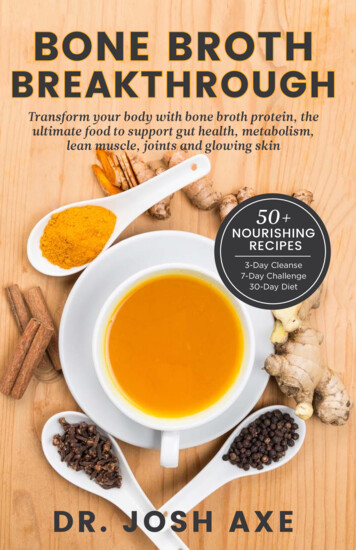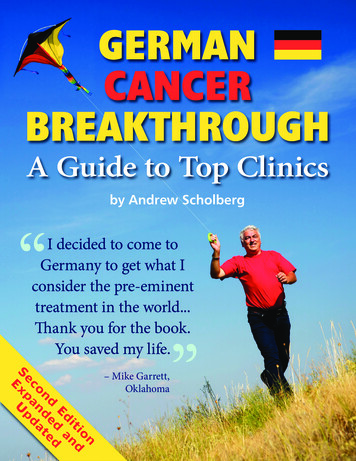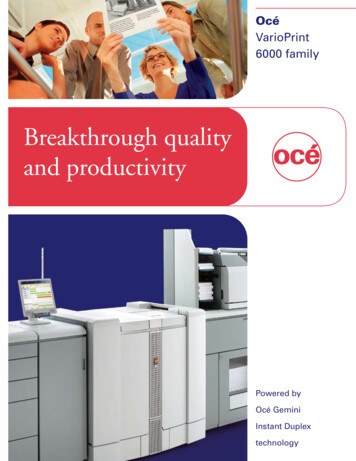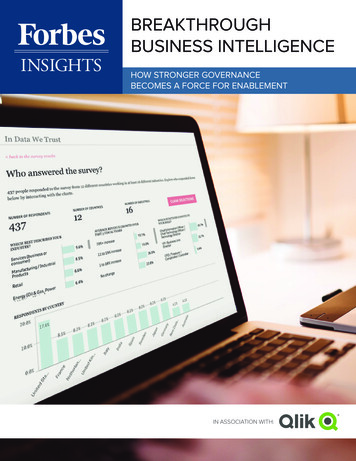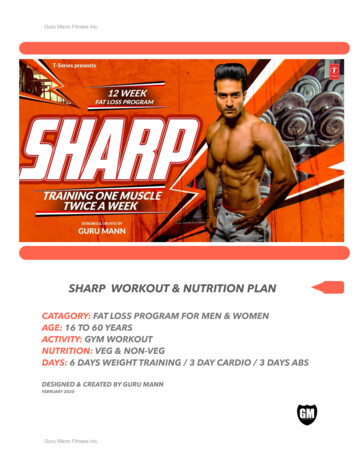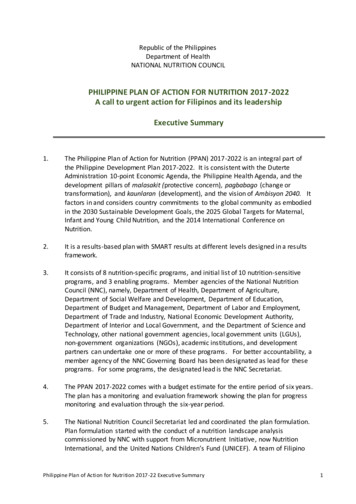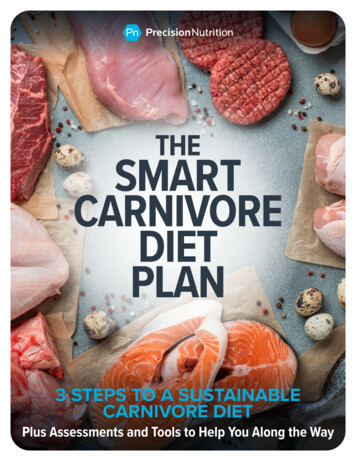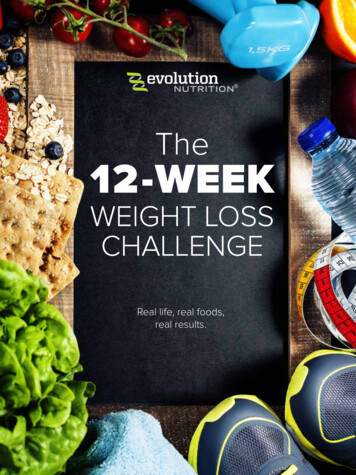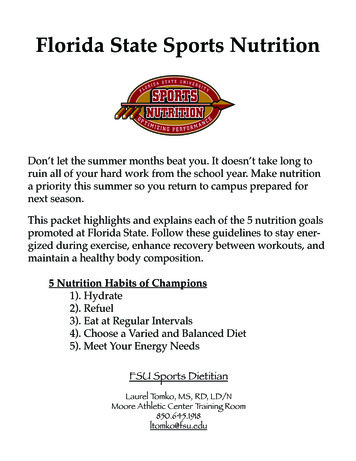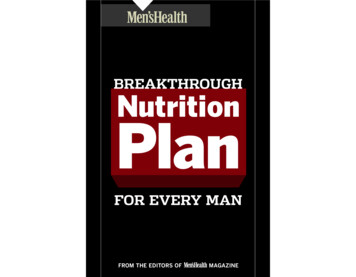
Transcription
mBREAKTHROUGHNutritionPlanFOR EVERY MANFROM THE EDITORS OF mwww.menshealth.comMAGAZINE
EXPERT ADVICEYOU CAN TRUST—FROM MEN’S HEALTH!CONTENTSPrime-Time NutritionMen’s Health is committed to offering responsible, practical advicefor the intelligent man—supported by professionals and legitimatescientific research.Before you undertake a new health program or fitness regimen, weencourage you to discuss your plans with your health care professional, especially if you have not exercised for several years, areover 35, or are overweight.The information here is designed to help you make informed decisions about your health. It is not intended as a substitute for anytreatment prescribed by your doctor. If you suspect that you have amedical problem, please seek competent medical care. 2003 by Rodale Inc.4GOAL: WEIGHT LOSS5The Importance of Muscle in Weight Loss6The 3-Count Plan11Turn Up the Burn13GOAL: BIGGER MUSCLES15How Much to Eat16What to Eat18When to Eat22Sample Meal Plans24GOAL: PREVENTING DISEASE27The Mystery of Inflammation28Magic Ratio Plan: 2 to 134Eat to Beat Prostate Cancer36Eat to Beat High Blood Pressure37Nutrition to Boost Energy39BONUS SECTION: GREAT EATS41Project editor: Krissa Y. StraussCopy editor: Alison Stubits AckermanDesigner: Maia Ranieriwww.menshealth.com
PRIME-TIME NUTRITIONReading that french fries aren’t as good for you as a baked potato ishardly startling. By the time you are an adult, you know that eatingwell is an important contributor to how you look and feel. But whatis prime-time news is how what you eat can help you accomplishcertain goals—for example, losing weight, building muscle, or keeping your immune system strong and healthy. That’s the genesis ofthe Breakthrough Nutrition Plan for Every Man—we give you the verylatest research on how your food choices affect your health, growth,and well-being.Crash course in weight loss. In the first section of thisbooklet, we present powerful help for those of you who want to dropa couple of pant sizes. More than just flashy stories on morning talkshows, this information includes the latest on low-carb diets andtells you why they really work.Strong muscles need strong food. Are you lifting weights inhopes of building a sculpted body? You probably already know thateating meat is essential for building muscle. But did you know thatfats are important as well? Get the latest news on how to build a lotof muscle without adding a lot of fat—and, conversely, how to holdonto the muscle you’ve already got if you’re pudgy around the waist.We simplify it with formulas that will tell you exactly how manycalories you need to consume to gain muscle or to lose fat. Then wemake it even easier by supplying you with sample eating plans.Stop disease before it starts. This section provides groundbreaking news on the mystery of inflammation—the cause of manymajor conditions. Scientists are finding that chronic inflammationcan cause the body to attack itself with friendly fire. Learn how thewrong kind of diet can set that spiral in downward motion, increasingthe risk of heart attack, stroke, and other disease. Then learn whichfoods offer protection, lowering risks for the major diseases men areprone to, especially as they grow older. And because guys like to eat,but not necessarily to cook, we’ve thrown in some great ways tomake meals taste better while giving you a healthy dose of nutrition.Last but not least, in case cooking is your thing, there is a bonussection of great recipes, each annotated for its particular nutritionbenefit. Each is easy to make and hard to put down.Here’s to your health! Goal: Weight LossThere is no one thing that causes men to gain weight. For some, itmay be a lack of exercise or lifestyle choices; for others, it’s geneticsor family history, or a combination of any or all of those factors.But the overriding reason we get fat is simply because we consumetoo many calories.Wait a minute, you say—there’s nothing simple about it. Hey,if it were that easy to deny ourselves, we’d all look like gods. Butprobably one of the most interesting breakthroughs in dieting isthat calories aren’t the primary focus of some new and very successful weight-loss plans. In fact, how much you eat may not beas crucial to weight loss as what you eat.For starters, fats are no longer the bad boys of the food world,lurking in the food aisles with lots of calories and not much more.And eating lots of carbohydrates—even healthy vegetables andgrains—may pack on the pounds as readily as cheese and steaks do.In fact, researchers are finding that certain carbs cause more metabolic problems in weight control than any other food you put inyour mouth.There are low-carb diets helping people lose weight and curetheir cravings for the first time in their lives. The Atkins Diet wasthe first to focus on fats and protein as the basis of its success.More recently, the South Beach Diet, which is a modification of theprotein-good carbs/bad carbs premise, has had amazing success.www.menshealth.com4
WHATTHE IMPORTANCEOF MUSCLEIN WEIGHT LOSSAccording to The Testosterone Advantage Plan, a diet-and-exercisebook written by Lou Schuler with Jeff Volek, RD, PhD, MichaelMejia, and Adam Campbell, you want to add as much muscle toyour body as possible because that will speed up your metabolismand lead the assault on your body’s fat. And protein will speed upyour metabolism and slow down your appetite. It will also make youfeel full faster than either carbohydrates or fats.Need more convincing? Your body uses more energy to digestprotein than it does to process carbohydrates or fat, according toDouglas Kalman, RD, a spokesperson for the American College ofSports Medicine. “That means that the more protein you eat, theharder your body has to work to digest it,and the more calories you’ll burn in theWHAT TO EATprocess,” he says. When researchers atArizona State University compared the Lean beefbenefits of a high-protein diet with those Chicken breastof a high-carbohydrate diet, they found Turkey breastthat people who ate a high-protein diet All types of fishburned more than twice as many caloriesin the hours following their meal as thoseeating carbs.Finding the Good CarbohydratesYou don’t have to forgo carbohydrates, but there are good ones andbad ones. The carbohydrate foods you should concentrate your dieton are those that keep your blood sugar steady for a few hours afteryou eat them.Here’s how it works: All carbohydrates, including the lactose inmilk, the starch in a bagel, the sucrose in table sugar, are convertedby your body into glucose, or blood sugar. This is our primarysource of energy. All of the carbs you eat turn into glucose, but onlyTOEATBreads: Pumpernickel, sourdoughGrains: Barley, parboiled rice, bulgur, kashaPasta: Angel hair, linguine, and other thin strands; bean threads(cellophane noodles); whole grain spaghettiCereals: Rice bran, unsweetened high-fiber (all bran) cerealsVegetables: Sweet potatoes, yams, green peas, tomatoesFruits: Mangoes, bananas, kiwifruit, oranges, grapes, apples,pears, strawberries, dried apricots, peaches, plums, cherriesSnacks: Cheese, nuts, olivesProtein foods: Unsweetened peanut butter, beans, eggs, unsweetened soy milkMiscellaneous: Low-fat yogurt, foods sweetened with sucralose,saccharin, fructose, or aspartame58 percent of the protein and 10 percent of the fat you eat is converted. So carbohydrates are often regarded as energy foods. Carbsalso turn into sugar very fast, faster than protein or fat. That’s whywhen you down a candy bar when you are hungry, you feel fullquickly. You are raising your blood sugar.Now it gets really interesting. Although all carbohydrates areconverted to glucose and raise your blood sugar, not all do it at thesame rate. And it’s not as simple as saying it’s the refined carbs thatdo it the fastest. Researchers have found that this isn’t always thecase. They have developed a system called the glycemic index (GI),which ranks carbohydrate-containing foods according to howquickly they raise your blood sugar (with pure glucose given thehighest ranking of 100) within a 2- to 3-hour period after consumption. The higher the GI, the quicker the food breaks down and jacksup your blood sugar. The lower the number, the more gradually thefood is absorbed and the more slowly it raises your blood sugar. Theresult is that it keeps you feeling fuller longer, and you are lesslikely to start hitting chips and dip a couple of hours after eating.These are good carbohydrates.Also playing a role in this chemical reaction is insulin. Insulin iswww.menshealth.com67
a hormone that is fine in moderation, but not in excess. Glucosestimulates the release of insulin by the pancreas. The function ofinsulin is to grab the glucose and deliver it to your body’s cells,where it’s either converted into energy or stored as fat (which it willbe if there is already more than enough glucose available to meet current needs).Fats That Fit Your DietUntil recently, fat was considered the primary culprit in makingpeople fat, and high-carb diets were the standard. The result?Americans have just gotten fatter. In addition, adult-onset diabeteshas become more widespread.What went wrong? First, it was thought that the new low-fatAmerican diet would mimic the low-fat, high-carb regimen of countries like China and Japan, which had very low heart attack rates. Butthe U.S. food industry stepped in to provide us with low-fat foodsthat tasted good. It created delicious, highly processed foods,including cookies and baked goods prominently (and accurately)advertised as low fat, no cholesterol. This is the source of the“empty calories” nutritionists decry. In whole foods, the sugars andstarches are bound up with the fiber and nutrients, so when we eatwhole grain rice, we get the entire package. Processing removes thefiber (and hence, the nutrients) in order to make that rice easier andfaster to cook. But as a result, all we get is the starch and the calories—empty of the necessary fiber and nutrients.In addition, the U.S. Department of Agriculture’s (USDA) dietpyramid was built on a base of the so-called “complex carbohydrates”—bread, pasta, rice. Americans took it to mean that theycould eat these foods in abundance and still live thin, healthy, andhappily ever after.Make that fat ever after. It turns out that the United Statesand the northern European countries with the high fat intake andhigh heart attack rates also had the lowest levels of fiber in theircarbohydrates. By contrast, less-developed countries with highcarbohydrate, low-fat diets had lots of fiber in their carbs. In the1990s, the Harvard School of Nutrition, under the guidance ofDr. Walter C. Willet, looked at the correlation between fiber andheart attack rates. The finding: When people eat high-fiber carbssuch as vegetables and unprocessed grains and flour, the danger ofTHE GOOD OILSThey’ve all got the same number of calories (120 per tablespoon), but they aren’t all equal in other aspects. Here’s a breakdown of their monounsaturates (best), polyunsaturates (good),saturates (bad), and how to use each oil in cooking. Olive oil. 77 percent monounsaturates, 9 percent polyunsaturates, 14 percent saturates. This is your healthiest choice, but thedifferent types have their own advantages and disadvantageswhen it comes to cooking. Extra-virgin is very rich in flavor andexpensive, so it’s best for uncooked dishes and flavoring, such ason salads. Virgin olive oil is slightly more acidic and toleratesheat better, so it’s good for sautéing. “Light” refers to the oil’scolor, not its fat content; use it for frying and baking. Canola oil. 62 percent monounsaturates, 31 percent polyunsaturates, 7 percent saturates. It’s flavorless but holds up fairly wellin heat, making it ideal for frying, sautéing, and baking. Corn oil. 25 percent monounsaturates, 62 percent polyunsaturates, 13 percent saturates. It has a mild flavor and doesn’t holdup well in heat, so it’s best used in dressings or light frying. Walnut oil. 24 percent monounsaturates, 66 percent polyunsaturates, 10 percent saturates. It has a rich flavor but breaks downin heat. It’s best used in dressings, sauces, and baking. Soybean oil. 24 percent monounsaturates, 61 percent polyunsaturates, 15 percent saturates. The flavor is bland, but it tolerates heat well; use it for sautéing and frying. Note: This is labeledas “vegetable oil” on packaging.most dietary fat becomes minimal. Only saturated fat remains apredictor of heart attacks, and even then not a very impressive one.Sure, ounce for ounce, fats have more calories than carbs. We’vealways known this, but we’ve misunderstood the significance. Wetook it to mean that carbs are less fattening. In reality, the oppositemay be true. When we eat fats, we become satiated. As a result, weknow when to stop eating.www.menshealth.com89
Fill Up on Whole FoodsHere’s an incontrovertible fact: To lose 1 pound, you need to burn anextra 3,500 calories or take in 3,500 less than usual (or do a combination of both). That’s total calories, not just fat calories. Somewherealong the line, people came to believe that low-fat and reduced-fatfoods are magic weight-loss remedies. Not so. For example, switching to low-fat chocolate chip cookies will only save you 8 caloriesper 1-ounce serving.For a dietary strategy that works better than any reduced-fatplan, eat low-calorie, high-density foods—bulky foods that fill youup without adding tons of calories. The easiest way to do that: Pickwhole foods rather than processed foods whenever possible. Rich infiber, they take longer to digest and make you feel fuller longer, soyou’ll eat less. Studies show high-fiber diets help people curbhunger, absorb fewer calories, and lose weight.HOWTOLOSE 1 POUNDAWEEKHere are eight great examples of how to shave 200–300 caloriesin a day. Simple daily subs like these can shed 10 pounds in 16weeks. Add in calories burned by bike riding just 30 minutes aday (250–300), and you’ll lose a pound a week.Instead ofEatand Savewhile Gaining(calories)(grams of fiber)Apple juice(8.5 oz.)Apple424.0Potato chipsBoiled potato400.0Corn chips(1 oz.)Corn on the cob(w/salt and pepper)466.0Blueberry pie(1 packaged)Blueberries and Grape-Nuts(1 2 cup each, w/water nuked)1030.8Klondike BarFrozen fruit bar792.7Peanut buttercrackers(6-pack)Whole wheat breadwith peanut butter(1 slice, 2 teaspoons)425.0Eggo bananawaffles (2)Banana950.3White pasta(1 cup)Bulgur (1 cup)2050.0THE 3-COUNT PLANMaybe you don’t want to be botheredwith counting calories or points orWHAT TO EATknow you won’t be satisfied with punyportions. If you’re committed to losingHere are examplesweight, but can’t commit to giving upof quick three-foodyour favorite foods, try the “three-foodsnacks:rule.” Instead of focusing on all the String cheese,things you can’t have, this revolutioncherry tomatoes,ary approach actually encourages yougrapesto eat more. And it actually works. Yogurt, crackers,Developed by Orlando-based nutricarrot stickstion counselor Karen Beerbower, RD, Hard-cooked egg,the three-food rule is simple: Everybanana, trail mixtime you eat, choose a combinationof three food items. Each item shouldcome from a different food group,and one item must be a protein. That’s it. “It’s a rule with noexceptions—and exceptional benefits,” says Beerbower, author ofSetting Places (Nutritional Guidance, Inc., 2000), who developed therule to teach her clients how to eat more healthfully. Unexpectedly,many of them also lost weight—sometimes a lot of weight—as aresult.How It WorksThe rule works because it gives you structure, satisfies yourappetite with a healthy variety of foods, and allows you to eat allthe foods you crave. Want a doughnut? Fine, but also have a glass ofmilk and an orange. Macaroni and cheese for dinner? Great. Justinclude two more items, such as fresh green beans and an apple. Ifyou want seconds on the mac and cheese, that’s okay too, but youmust have seconds on the beans and apple as well. Pick from thesefood groups: fruits, vegetables, dairy, grains, and meat (includesfish, eggs, nuts, legumes).“People can’t believe I’m actually telling them to eat more food,www.menshealth.com1011
but the idea is to satisfy your hunger and dissuade you from eatingwhen you’re just bored,” Beerbower says. When midmorning hungerpangs hit, for instance, you may try to satisfy yourself with just anapple. But if that doesn’t do the trick, you grab some pretzels, then amuffin, and then some M&M’s. “You’ll actually eat fewer calories inthe long run by having a well-thought-out snack.”Likewise, say it’s 3 PM, and you’re just bored. Normally, youmight take a vending machine break. But with the three-food rule,you can’t just grab a Snickers for instant gratification. You have todo a little work to come up with two other foods, one of which is aprotein. You’re forced to think about what and why you’re eating. “Ifyou’re not hungry, you’ll be more likely to decide the snack isn’tworth the fuss and skip it and the calories,” Beerbower says.And even if you eat all three food items (sure, it’s more caloriesthan if you just had the candy bar), you’ll be fuller longer and morelikely to eat less later. So over time, you’re eating fewer calories.Protein PowerIt’s the secret of protein, once again.SO LONG TO SUDSThe three-food rule also helps youIf you are serious aboutfeel more satisfied and less hungrylosing weight, you shouldbecause you’re eating the properknow that people whoamounts of protein, says Beerbower.drink the most alcoholProtein slows digestion and increaseshave larger waistlines insatiety.relation to their hips“Clients never come in and say, ‘Ithan those of teetotalers.just ate six broiled chicken breasts,In other words, the beerbelly is not a myth.boy, am I stuffed,’” she says. WhenApparently, alcoholyou overeat, it’s almost always ondeposits fat in the midstarchy, sweet, or salty snacks. Withsection, which puts menthe three-food rule, you can still haveat risk for liver diseasethose treats, but the addition of aand increased risk forprotein food breaks the craving andheart disease.stops you from falling into a carbohydrate fog.Protein also helps maintain lean body tissue, and it assists in theformation of important compounds that supply energy and sharpenyour mental focus and cognitive skills. Good sources include meat,eggs, dairy products, fish, seeds, nuts, and legumes.TURN UP THE BURNThese foods are like speed for your metabolism. Eat them, andyou’re guaranteed to burn more calories, just by sitting there.Although the boost is temporary, if you eat a few of these snacksduring the day, in time you will lose weight. And that’s if you'redoing nothing.Whole grain cereals. These are complex carbohydrates and fiberthat pump up metabolism by keeping insulin levels low after you eat.That’s good, because spikes in the production of insulin send asignal to the body that it’s time to start storing fat. And in order tostockpile fat, your body has to slow down your metabolism, causingyou to burn fewer calories, says Margaret McNurlan, PhD, a professor of nutrition and medicine at the State University of New York atStony Brook.Besides helping to keep insulin production down, eating breakfast can also help stoke your daily calorie burn. When the U.S. Navystudied the metabolisms and eating habits of a group of its personnel, it found that eating breakfast helped raise the men’s metabolisms by as much as 10 percent. “By skipping meals, you slow downyour metabolism and prime your body to store fat,” says McNurlan.Calcium. This mineral is a metabolic trigger as well. A University of Tennessee study found that dieters who consumed between1,200 and 1,300 milligrams (mg) of calcium a day lost nearly twice asmuch weight as dieters getting less calcium. An 8-ounce glass ofmilk contains about 200 mg of calcium.Jalapeño, habanero, and cayenne peppers. These contain capsaicin—the chemical that gives them their bite. A study from thelate ’80s found that eating a single spicy meal can boost yourmetabolism by up to 25 percent, with the spike in calorie burninglasting for up to 3 hours after you finish eating. More recently, astudy from Laval University in Quebec found that men who consumed coffee plus red pepper–packed snacks and meals were ablewww.menshealth.com1213
to burn nearly 1,000 more calories a day than a control group.Green tea and coffee. These beverages contain caffeine, which helpsspeed up your heart rate. The faster your heart beats, the more caloriesyou burn.The EGCG in these drinks works in a similar way, but instead ofrevving up your heart, it causes your brain and nervous system to runmore quickly—again helpingWATER AND WEIGHT LOSSyou burn morecalories.If you are increasing your protein intake, youIn studies,should be aware that you will lose a fewresearcherspounds of water almost instantly. This is onefound that areason why high-protein diets have such dracombination ofmatic results in the early stages.caffeine and aThere’s a vanity angle at play too. When90-mg dose ofyou don’t drink enough water, your body actuEGCG takenally retains fluid, making you look tired andthree times a daypuffy. But when your body gets enough water,can help youit doesn’t bother holding on to any extra.burn an extra 80Most guys need 5 to 6 pints of fluid a day.calories a day.That’s 80 to 96 ounces. The easiest way toAnd that’s justmake sure you get enough is to get yourself awhen yourquart container, fill it up, and down it threebody’s at rest. Atimes a day.study conductedby the Canadiangovernment found that soldiers who consumed caffeine in the 12 hoursprior to a physical-fitness test not only were able to work out longerbefore becoming exhausted, but also consumed more oxygen while working out. The body’s oxygen requirements are directly related to the speedof your metabolism, so the more oxygen you use, the more calories youburn during your workout. Goal: Bigger MusclesTo build your muscles, you need a strength training program. You alsomust give your muscles extra calories—that is, you must eat morecalories than you burn off. There isn’t any magic ratio of protein,carbohydrate, and fat that will optimize muscle gain. Simply eatenough food while working out regularly, and you will gain weight.Some newcomers to strength training find that their bodiesrespond so rapidly to the muscle-building workout stimulus that theybuild muscle and lose fat simultaneously, with a gain or no change inoverall body weight. Most guys aren’t so lucky. If you’ve been trainingconsistently for at least a year, you’ll have to accept that when youincrease your calorie intake to gain muscle, you’ll also gain some fat.So at some point, you’ll need to concentrate on pure fat loss by creating a calorie deficit.You decide how to schedule your muscle-building and fat-lossphases. You do a workout program while eating more, switching to afat-loss phase only after completing your program. Or you can eat lessduring your program, to cut weight throughout. A third option is tojump-start fat loss by cutting calories when you first start a program,increase calories in the second and third (hypertrophy and strength)stages to bulk up a bit, and then cut again in the fourth, power phase.Looking for news on losing weight fast? Check theWeight Loss Bulletin for the latest info on breakthrough diets.www.menshealth.com14
Step 3:Your Basic Calorie Needs Your Metabolic Rate Your Maintenance TotalHOW MUCH TO EATIt’s easy for us to say “Eat more to gain muscle” and “Eat less to lose fat.”That still leaves you with a big question: more or less than what? Youneed a baseline number to start with.So whip out the calculator, and let’s figure out that magic number.Step 1:Your weight in pounds 11 Your Basic Calorie NeedsThis calculation tells you the amount of energy you’d burn without eatingor exercising. It reveals your basic calorie needs—the caloric cost of beingyou.Step 2:Your Basic Calorie Needs caloric cost of your activity level(see chart below) % Your Metabolic RateSince you do eat and exercise, the total number of calories your bodyburns in a day is higher than your basic calorie needs. How much higherdepends on your age, the amount of muscle you have, and the intensity atwhich you make that muscle work. Multiply your basic calorie needs byone of the following percentages to estimate the number of calories youburn metabolically. (Note that these percentages are averages; your actualmetabolism may be faster or slower than these typical rates.)ACTIVITY LEVELAGE 3030–40 40Mostly sedentary30%25%20%Moderately active40%35%30%Dedicated exerciseror athlete50%45%40%This sum reveals how many calories you need just to maintain yourcurrent body composition, without growing muscle or shedding fat.Step 4:Your Maintenance Total 500 To Gain MuscleTo build muscle, increase your daily calorie intake by 500 calories.Step 5:Your Maintenance Total – 500 To Lose FatTo lose weight, subtract 500 calories a day.The amount of energy in a pound of fat equals 3,500 calories, so in aperfect world, creating a daily surplus or deficit of 500 calories wouldallow weight gain or weight loss of 1 pound a week. This equation is mostaccurate when you try to lose weight. Muscle gain is less predictable thanfat loss, because adding calories and moving a heavier body both speed upyour metabolism.Let’s run an example. Say you weigh 165 pounds, you’re under 30, andyou’re extremely active, lifting 3 days a week and playing sports or doingsome other type of intense exercise on other days. You want to gain somesolid muscle mass.Step 1: 165 11 1,815Step 2: 1,815 0.5 907.5Step 3: 1,815 907.5 2,722.5Step 4: 2,722 500 3,222.5In other words, you need to eat more than 3,200 calories a day to gainmuscle mass.Now say you’re a 45-year-old, 230-pound guy who’s mostly sedentaryand wants to lose weight aggressively—2 pounds a week.Step 1: 230 11 2,530Step 2: 2,530 0.2 506Step 3: 2,530 506 3,036Step 4: 3,036 – 1,000 2,036Your basic caloric needs x caloric cost of your activity level % www.menshealth.com1617
WHAT TO EATDuring a strength-training regimen, your first dietary considerationis to get enough protein, either to build muscle or maintain musclewhile shedding fat. We recommend close to a gram of protein perpound of body weight.If you’re a lean, very active guy trying to pack on muscle, youshould hedge your bets with more than a gram of protein per pound,since extra dietary protein increases protein synthesis in the body.At the same time, you need plenty of easily available fuel in theform of carbohydrate. (The more intense the activity, the more carbohydrate your body uses for energy.) Without a lot of carbs, yourun the risk that your body will dip into your protein reserves forthe energy it needs. Those protein reserves are in your muscles—the last place from which you want to donate energy.Finally, you need enough fat to help produce testosterone andother anabolic hormones. And the fat can be used for energy, too,especially during any low-intensity activities—shooting hoops,playing golf, riding a bike.When trying to shed fat, you have a slightly different set of concerns. You need protein to maintain your muscle even though youcan’t expect to gain muscle mass while trying to lose 2 pounds aweek. You want those pounds to come entirely from your fat stores,so you shouldn’t eat a lot of carbohydrate. Eating carbs signals yourbody to burn carbs. Eat fat, though, and your body will be morewilling to use fat for energy.However, you shouldn’t completely forgo carbohydrates. Youneed some for energy during exercise; you need fruits, vegetables,and whole grains for health reasons; and you don’t want to feeldeprived of the foods that comprise the vast majority of the available calories in the food chain. You’re already cutting out a largechunk of your daily calories—don’t pile on needless suffering byeating like a freak.Does all this mean you have to follow a formal diet, countingevery calorie? We think the answer is yes. If you’re trying—and failing—to grow muscle or lose fat, you probably do need to follow acarefully calculated diet, at least for a while. Start by determiningyour actual food intake: Keep a 3-day food diary, making a list ofeverything you eat during that 72-hour period. Use a good caloriecounting Web site, such as www.usda.gov, to figure out your average daily calorie intake. Then you’ll be able to cut or add calories asnecessary to reach the total you calculated back on page 16.A simpler strategy is to examine your diet for less healthfulfoods and replace those with better ones, using the chart below.Bad FoodsThey’re Bad Because . . .Except . . .Better FoodsPROTEINBeef or pork ribsBrisketGround beefPork sausageVery high in saturated fat,which is linked to heart disease;goes down so fast your bodydoesn't have time to activate itsappetite-controlling mechanismsEggsFish, includingwater-packedcanned tunaLean cuts suchas sirloin,flank, ortenderloin90% leanground beefor turkey,chewedslowlyReduced-fatlunchmeats(roast beef,turkey, ham)Skinlesschicken orturkey breastTurkey sausageWhey-proteinor toesQuickly digested, leaving you feelinghungry again soon after. Best to eatcarbohydrate that packs some fiber,because fiber slows the emptyingof food from your stomach, makingyou feel fuller longer; fiber is alsolinked to a lower risk of heartdiseaseSugar-laden orlow-fiber breakfastcerealsWhite breadImmediatelybefore or aftera workout,when you cancombine themwith goodprotein such aseggs or low-fatdairy productsRye breadSweet potatoesWhole grainbreads, pastas,riceWhole wheatbaked tortillasWhole wheatpitasAll-BranFiber OneGrape-NutsPlain oldfashionedoatmeal(not instant)Raisin branShredded WheatShredded Wheat'N BranWhite ricewww.menshealth.com1819
Bad F
According to The Testosterone Advantage Plan, a diet-and-exercise book written by Lou Schuler with Jeff Volek, RD, PhD, Michael Mejia, and Adam Campbell, you want to add as much muscle to your body as possible because that will speed up your metabolism and lead
